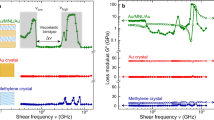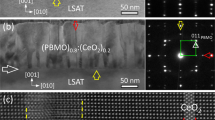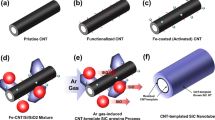Abstract
Self-assembled molecular nanolayers (MNLs) composed of short organic chains and terminated with desired functional groups are attractive for modifying surface properties for a variety of applications. For example, organosilane MNLs are used as lubricants1, in nanolithography2, for corrosion protection3 and in the crystallization of biominerals4. Recent work has explored uses of MNLs at thin-film interfaces, both as active components in molecular devices5, and as passive layers, inhibiting interfacial diffusion6,7,8, promoting adhesion9,10 and toughening brittle nanoporous structures11. The relatively low stability of MNLs on surfaces at temperatures above 350–400 °C (refs 12, 13), as a result of desorption14 or degradation, limits the use of surface MNLs in high-temperature applications. Here we harness MNLs at thin-film interfaces at temperatures higher than the MNL desorption temperature to fortify copper–dielectric interfaces relevant to wiring in micro- and nano-electronic devices. Annealing Cu/MNL/SiO2 structures at 400–700 °C results in interfaces that are five times tougher than pristine Cu/SiO2 structures, yielding values exceeding ∼20 J m-2. Previously, similarly high toughness values have only been obtained using micrometre-thick interfacial layers15,16,17. Electron spectroscopy of fracture surfaces and density functional theory modelling of molecular stretching and fracture show that toughening arises from thermally activated interfacial siloxane bridging that enables the MNL to be strongly linked to both the adjacent layers at the interface, and suppresses MNL desorption. We anticipate that our findings will open up opportunities for molecular-level tailoring of a variety of interfacial properties, at processing temperatures higher than previously envisaged, for applications where microlayers are not a viable option—such as in nanodevices or in thermally resistant molecular-inorganic hybrid devices.
This is a preview of subscription content, access via your institution
Access options
Subscribe to this journal
Receive 51 print issues and online access
$199.00 per year
only $3.90 per issue
Buy this article
- Purchase on Springer Link
- Instant access to full article PDF
Prices may be subject to local taxes which are calculated during checkout




Similar content being viewed by others
References
Qian, L., Tian, F. & Xiao, X. Tribological properties of self-assembled monolayers and their substrates under various humid environments. Tribol. Lett. 15, 169– 176 (2003)
Yang, X. M., Peters, R. D., Kim, T. K. & Nealey, P. F. Proximity X-ray lithography using self-assembled alkylsiloxane films: Resolution and pattern transfer. Langmuir 17, 228– 233 (2001)
Dressick, W. J. & Calvert, J. M. Patterning of self-assembled films using lithographic exposure tools. Jpn. J. Appl. Phys. 32, 5829– 5839 (1993)
Kuther, J. & Tremel, W. Template induced crystallization of biominerals on self-assembled monolayers of alkylthiols. Thin Solid Films 327–329, 554– 558 (1998)
Halik, M. et al. Low-voltage organic transistors with an amorphous molecular gate dielectric. Nature 431, 963– 966 (2004)
Krishnamoorthy, A., Chanda, K., Murarka, S. P., Ramanath, G. & Ryan, J. G. Self-assembled near-zero-thickness molecular layers as diffusion barriers for Cu metallization. Appl. Phys. Lett. 78, 2467– 2469 (2001)
Ganesan, P. G., Gamba, J., Ellis, A., Kane, R. S. & Ramanath, G. Polyelectrolyte nanolayers as diffusion barriers for Cu metallization. Appl. Phys. Lett. 83, 3302– 3305 (2003)
Ganesan, P. G., Singh, A. P. & Ramanath, G. Diffusion barrier properties of carboxyl- and amine-terminated molecular nanolayers. Appl. Phys. Lett. 85, 579– 581 (2004)
Ferguson, G. S., Chaudhury, M. K., Sigal, G. B. & Whitesides, G. M. Contact adhesion of thin gold films on elastomeric supports: Cold welding under ambient conditions. Science 253, 776– 778 (1991)
Ramanath, G. et al. Self-assembled subnanolayers as interfacial adhesion enhancers and diffusion barriers for integrated circuits. Appl. Phys. Lett. 83, 383– 385 (2003)
Maidenberg, D. A., Volksen, W., Miller, R. D. & Dauskardt, R. H. Toughening of nanoporous glasses using porogen residuals. Nature Mater. 3, 464– 469 (2004)
Neves, B. R. A., Salmon, M. E., Russell, P. E. & Troughton, E. B. J. Thermal stability study of self-assembled monolayers on mica. Langmuir 16, 2409– 2412 (2000)
Ishida, T. et al. Annealing effect of self-assembled monolayers generated from terphenyl derivatized thiols on Au(111). Langmuir 18, 83– 92 (2002)
Senkevich, J. J., Yang, G. R. & Lu, T. M. Thermal stability of mercaptan terminated self-assembled multilayer films on SiO2 surface. Colloids Surf. A 207, 139– 145 (2002)
Gandikota, S. et al. Adhesion studies of CVD copper metallization. Microelectron. Eng. 50, 547– 553 (2000)
Litteken, C. S. & Dauskardt, R. H. Adhesion of polymer thin-films and patterned lines. Int. J. Fract. 120, 475– 485 (2003)
Snodgrass, J. M., Pantelidis, D., Jenkins, M. L., Bravman, J. C. & Dauskardt, R. H. Subcritical debonding of polymer/silica interfaces under monotonic and cyclic loading. Acta Mater. 50, 2395– 2411 (2002)
Dauskardt, R. H., Lane, M., Ma, Q. & Krishna, N. Adhesion and debonding of multi-layer thin film structures. Eng. Fract. Mech. 61, 141– 162 (1998)
Lane, M., Dauskardt, R. H., Krishna, N. & Hashim, I. Adhesion and reliability of copper interconnects with Ta and TaN barrier layers. J. Mater. Res. 15, 203– 211 (2000)
Evans, A. G., Rühle, M., Dalgleish, B. J. & Charalambides, P. G. The fracture energy of biomaterial interfaces. Metall. Trans. A 21, 2419– 2429 (1990)
Lane, M. Interface fracture. Annu. Rev. Mater. Res. 33, 29– 54 (2003)
Hu, M. et al. Effect of interfacial interactions on the initial growth of Cu on clean SiO2 and 3-mercaptopropyltrimethoxysilane-modified SiO2 substrates. J. Vac. Sci. Technol. A 20, 589– 596 (2002)
Teo, M., Kim, J., Wong, P. C., Wong, K. C. & Mitchell, K. A. R. Investigations of interfaces formed between bis-1,2-(triethoxysilyl)ethane (BTSE) and aluminum after different Forest Product Laboratory pre-treatment times. Appl. Surf. Sci. 221, 340– 348 (2004)
D’souza, A. S. & Pantano, C. G. Hydroxylation and dehydroxylation behavior of silica glass fracture surfaces. J. Am. Ceram. Soc. 85, 1499– 1504 (2002)
Ulman, A. An Introduction to Ultrathin Organic Films, from Langmuir-Blodgett to Self-Assembly 1st edn (Academic, San Diego, 1991)
Lane, M., Dauskardt, R. H., Vainchtein, A. & Gao, H. Plasticity contributions to interface adhesion in thin-film interconnect structures. J. Mater. Res. 15, 2758– 2769 (2000)
Guyer, E. P. & Dauskardt, R. H. Fracture of nanoporous thin-film glasses. Nature Mater. 3, 53– 57 (2004)
Wu, X., Vargas, M. C., Nayak, S., Lotrich, V. & Scoles, G. Towards extending the applicability of density functional theory to weakly bound systems. J. Chem. Phys. 115, 8748– 8757 (2001)
Acknowledgements
This work was supported by the US National Science Foundation, the US-Israel Binational Science Foundation, an Alexander von Humboldt fellowship, and New York state through the Interconnect Focus Center.
Author information
Authors and Affiliations
Corresponding author
Ethics declarations
Competing interests
Reprints and permissions information is available at www.nature.com/reprints. The authors declare no competing financial interests.
Supplementary information
Supplementary Information
This file contains Supplementary Figures S1-S4 with Legends and additional references. (PDF 281 kb)
Rights and permissions
About this article
Cite this article
Gandhi, D., Lane, M., Zhou, Y. et al. Annealing-induced interfacial toughening using a molecular nanolayer. Nature 447, 299–302 (2007). https://doi.org/10.1038/nature05826
Received:
Accepted:
Issue Date:
DOI: https://doi.org/10.1038/nature05826
This article is cited by
-
Viscoelastic bandgap in multilayers of inorganic–organic nanolayer interfaces
Scientific Reports (2022)
-
Hybrid carbon thermal interface materials for thermoelectric generator devices
Scientific Reports (2020)
-
Frequency-tunable toughening in a polymer-metal-ceramic stack using an interfacial molecular nanolayer
Nature Communications (2018)
-
Single-molecule interaction force measurements of catechol analog monomers and synthesis of adhesive polymer using the results
Polymer Journal (2016)
-
High-performance mussel-inspired adhesives of reduced complexity
Nature Communications (2015)
Comments
By submitting a comment you agree to abide by our Terms and Community Guidelines. If you find something abusive or that does not comply with our terms or guidelines please flag it as inappropriate.



